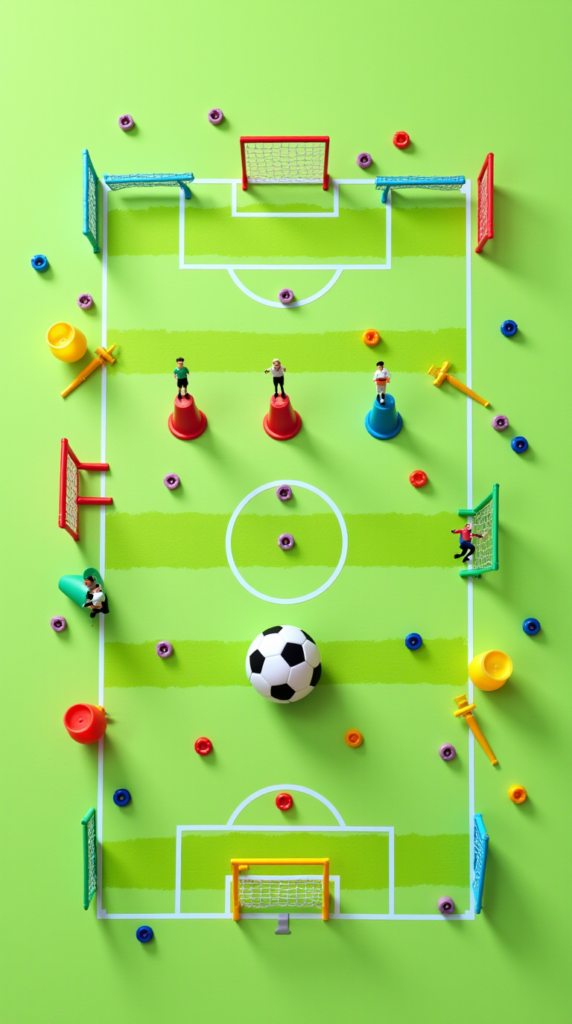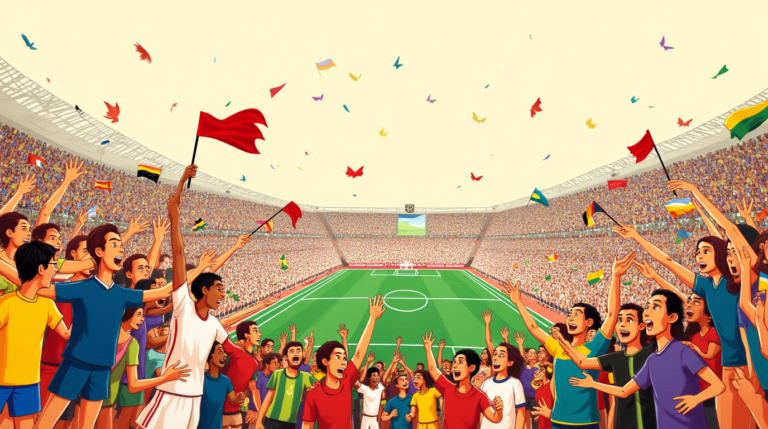A Brief History of Football
A Deeper Dive into Football History
Football, or soccer as it’s known in some parts of the world, truly earns its title as the «world’s game.» Its story is long and fascinating, stretching back through centuries and across continents. While the modern version originated in England, the roots of football-like games are much older and more widespread.
Ancient Origins Across Cultures: Long before modern rules, games involving kicking a ball were played in numerous ancient societies.
Ancient China: «Cuju» (蹴鞠), dating back to the Han Dynasty (2nd-3rd century BC), involved kicking a ball through an opening into a net. It was used for military training and later became a popular pastime.
Ancient Greece: Games like «Episkyros» and «Harpaston» involved teams trying to advance a ball past a line, using hands and feet. These were known for their physicality.
Ancient Rome: «Harpastum,» derived from the Greek game, was adopted by the Romans. It was a ball game played by teams, emphasizing physical exertion and possibly strategic elements.
 Indigenous Americas:Various ball games existed in pre-Columbian America, some with ritualistic significance. For example, Mesoamerican ballgames sometimes involved rubber balls and had complex rules and ceremonial aspects.
Indigenous Americas:Various ball games existed in pre-Columbian America, some with ritualistic significance. For example, Mesoamerican ballgames sometimes involved rubber balls and had complex rules and ceremonial aspects.
Medieval Folk Football: Chaos and Community: In medieval Europe, particularly in Britain and France, «folk football» or «mob football» emerged. These games were vastly different from today’s organized sport.
Village vs. Village: Matches often involved entire villages or parishes competing against each other. The «pitch» could be vast, stretching across fields and even through towns.
Minimal Rules, Maximum Chaos: Rules were almost non-existent or incredibly localized and informal. The primary objective was to move the ball (often an inflated animal bladder) to a designated location, like the opposing village’s church or town square.
Rough and Violent: These games were notoriously chaotic and often violent. Injuries were common, and there were few restrictions on tackling, pushing, or even punching. They were sometimes banned due to the disruption and damage they caused.
Community Events: Despite the chaos, folk football was a significant community event, bringing people together and releasing pent-up energy. They were often associated with festivals and holidays.
19th Century England: From Schools to Standardization: The 19th century in England was crucial for shaping modern football. Public schools (elite private schools) played a key role.
School Variations: Each school developed its own set of football rules. Schools like Rugby School favored handling the ball, while others like Eton and Harrow preferred kicking. This lack of uniformity made inter-school matches difficult and confusing.
The Need for Order: As football’s popularity grew beyond schools, the need for a standardized set of rules became increasingly apparent. Clubs were forming, and matches between different groups required a common understanding.
1863: The Football Association and the Birth of Modern Football: The pivotal year was 1863 when representatives from various football clubs and schools met in London to create a unified code.
Meetings at the Freemasons’ Tavern: These meetings took place at the Freemasons’ Tavern in Great Queen Street, London.
Separation from Rugby: A key point of contention was the issue of «hacking» (tripping opponents) and running with the ball in hand. The FA decided to outlaw these practices, leading to a split and the eventual formalization of rugby football as a separate sport.
The Laws of the Game: The Football Association codified the «Laws of the Game,» which laid the foundation for modern association football. These rules emphasized kicking, passing, and fair play.
Global Expansion and Enduring Popularity: From England, football spread rapidly across the globe.
British Influence: British sailors, soldiers, engineers, teachers, and businessmen played a major role in introducing football to other countries. They established clubs and organized matches in their new locations.
Early International Matches: The first official international football match is recognized as being played between England and Scotland in 1872.
Rise of National Leagues: National football leagues began to emerge in various countries in the late 19th and early 20th centuries, further organizing and popularizing the sport.
FIFA and Global Governance: In 1904, FIFA (Fédération Internationale de Football Association) was founded to govern international football, further solidifying its global structure and coordinating international competitions like the FIFA World Cup, first held in 1930.
Delving Deeper into the Basics of the Game
While football’s beauty lies in its fluidity and complexity, understanding the fundamentals is essential for any newcomer. Let’s expand on the basic elements of the game
The Clear Objective: Scoring Goals: The central aim is simple: outscore your opponent by getting the ball into their goal more times than they get it into yours. A goal is valid when the entire ball crosses the goal line, between the goalposts, and under the crossbar. Every match is a contest to achieve this objective.
Players and Their Roles: A Team of Specialists: Eleven players per team take the field, each with specific roles and responsibilities within a formation. Common positions include:
Goalkeeper (Number 1): The last line of defense and the only player allowed to use their hands within their own penalty area. Their primary job is to prevent shots from becoming goals. They also distribute the ball, often starting attacks.
Defenders: Positioned to protect the goal and stop opposing attackers.
Center-backs (Central Defenders): Stationed in the middle of the defense, they are strong in the air and in tackling, responsible for clearing danger and marking central attackers.
Full-backs (Wing-backs in some formations): Play on the flanks (sides) of the defense. Traditionally focused on defense, modern full-backs often contribute to attack, providing width and crosses.
Midfielders: The Engine Room: Connect defense and attack, controlling the tempo and flow of the game.
Central Midfielders: Often the most versatile players, involved in both attacking and defensive duties, controlling the center of the pitch, passing, tackling, and creating chances.
Defensive Midfielders (Holding Midfielders): Positioned just in front of the defense, their main role is to protect the backline, break up opposition attacks, and distribute the ball simply.

Attacking Midfielders (Playmakers): Positioned more advanced in midfield, focused on creating scoring opportunities, through passing, dribbling, and sometimes scoring themselves.
Wingers (Wide Midfielders/Forwards): Play on the flanks in midfield or attack. They provide width, cross the ball into the box, and take on defenders.
Forwards (Attackers): The Goal Scorers: Their primary function is to score goals.
Strikers (Center Forwards): Typically positioned centrally and highest up the pitch, they are the main goal-scoring threat, looking to get on the end of passes and crosses.
Second Strikers/Supporting Strikers: Play slightly behind or alongside the main striker, supporting attacks, creating space, and contributing goals.
Gameplay: Moving the Ball and Creating Opportunities: Football is a dynamic game of movement and ball control.
Passing: The Art of Distribution: Moving the ball between teammates is fundamental. Different types of passes include:
Short passes: Used for close control and maintaining possession.
Long passes: Switching play, reaching distant teammates, or launching counter-attacks.
Through balls: Passes played into space behind defenders for attackers to run onto.
Crosses: Long passes from wide areas into the penalty box, aimed at attackers.
Dribbling: Skillful Ball Control: Running with the ball under control, using footwork and technique to navigate past opponents. Effective dribbling creates space and opportunities.
Shooting: Aiming for Goal: Kicking the ball towards the opponent’s goal with the intention to score. Different shot types include:
Power shots: Hard, direct shots aimed to beat the goalkeeper with force.
Placed shots: Shots focused on accuracy, aiming for corners or areas difficult for the goalkeeper to reach.
Volleys/Half-volleys: Shots taken directly from the air, requiring excellent timing and technique.
Headers: Using the head to direct the ball, often from crosses or set pieces.
Match Duration and Extra Time: A standard match is 90 minutes, split into two 45-minute halves with a halftime interval, usually of 15 minutes. «Added time» or «stoppage time» is added at the end of each half to compensate for time lost due to injuries, substitutions, or other delays. In knockout competitions, if the score is tied after 90 minutes plus added time, extra time (typically two 15-minute periods) is played. If still tied after extra time, penalty shootouts decide the winner.
Fouls, Fair Play, and Set Pieces: Rules are in place to ensure fair play and player safety.
Common Fouls: Include tripping, pushing, tackling from behind, dangerous play, and handling the ball (handball – deliberately touching the ball with the hand or arm, except for the goalkeeper in their penalty area).
Consequences of Fouls:
Free Kicks: Awarded to the opposing team when a foul is committed outside the penalty area. Can be direct (shot directly at goal) or indirect (must touch another player before going into the goal).
Penalty Kicks: Awarded for fouls committed inside the penalty area. A direct free kick from the penalty spot, with only the goalkeeper defending.
Yellow and Red Cards: Yellow cards are cautions for unsporting behavior. Two yellow cards in a match result in a red card. Red cards are given for serious fouls, violent conduct, or denying a clear goal-scoring opportunity. A red card leads to immediate expulsion from the game and often a suspension from future matches.
The Offside Rule: Strategic Positioning: A rule designed to prevent players from simply lurking near the opponent’s goal waiting for easy passes.
Offside Position: A player is in an offside position if they are nearer to the opponent’s goal line than both the ball and the second-to-last opponent (usually the last defender, excluding the goalkeeper) at the moment the ball is passed to them by a teammate.
Not Offside: A player is not offside if they are in their own half of the pitch, or if they are level with the second-to-last opponent or the ball. Also, offside is only judged at the moment the ball is passed – their position when they receive the ball is irrelevant.
Purpose: The offside rule encourages more dynamic play, requires timing and tactical awareness, and prevents «goal hanging.»
Exploring the Global Love Affair with Football
Football’s immense popularity transcends mere sport; it’s a cultural phenomenon, a global language, and a source of deep passion. Let’s delve into the reasons behind its worldwide appeal.

Universal Simplicity and Accessibility: One of football’s greatest strengths is its inherent simplicity.
Easy to Understand Rules: The core rules are straightforward and quickly grasped, even by young children or those new to sports. You don’t need complex rulebooks to enjoy a game.
Minimal Equipment: Essentially, all you need is a ball and some open space. Goals can be improvised with jumpers or stones. This low barrier to entry means football can be played almost anywhere in the world, regardless of economic circumstances. It’s a sport of the streets, parks, and beaches as much as grand stadiums.
Unpredictable Excitement and Dramatic Tension: Football matches are rarely predictable, creating constant excitement and drama.
Goals are Precious: Goals can be relatively infrequent compared to some other sports, making each one feel incredibly significant and valuable. This raises the stakes and intensifies every attacking move.
Momentum Shifts and Comebacks: Games can swing dramatically. A team can be dominating and then concede a goal, completely changing the momentum. Comebacks from behind are common and incredibly thrilling, creating unforgettable moments.
Nail-biting Finishes: Many matches are decided by a single goal, or even go to penalties after extra time. This uncertainty and the potential for last-minute drama keep fans on the edge of their seats until the final whistle.
Teamwork, Strategy, and Tactical Depth: While individual brilliance is admired, football is fundamentally a team sport that demands coordination and strategic thinking.
Collective Effort: Success relies heavily on teamwork, communication, and understanding between players. A team of average individuals playing cohesively can often outperform a team of talented individuals lacking synergy.
Tactical Formations and Approaches: Coaches employ various formations and tactical strategies to outwit opponents. Analyzing formations, positional play, and tactical changes adds another layer of intellectual engagement for fans.
Strategic Battles: Matches are often strategic battles between coaches and teams, trying to exploit weaknesses and nullify strengths. This tactical dimension makes football intellectually stimulating as well as physically exciting.
Passion, Emotion, and Identity: Football evokes intense emotions in players and fans alike, creating a powerful sense of connection and belonging.
Fan Culture and Loyalty: Supporting a football team is often deeply ingrained in personal and community identity. Fans are incredibly passionate, creating vibrant atmospheres at matches and displaying unwavering loyalty through thick and thin.
Derby Matches and Rivalries: Local derbies or rivalries between historically opposed teams generate intense passion and often represent local pride and historical narratives.
Emotional Rollercoaster: Football fandom is an emotional rollercoaster. The highs of victory are euphoric, and the lows of defeat can be crushing. This emotional investment is a core part of the football experience.
Global Community and Shared Experience: Football transcends geographical boundaries and cultural differences, creating a truly global community.
FIFA World Cup: The World Cup is the pinnacle of international football, bringing nations together in a shared spectacle watched by billions worldwide. It fosters a sense of global unity and friendly competition.
Global Fanbases: Top clubs like Real Madrid, Barcelona, Manchester United, etc., have massive fanbases spanning continents. People from vastly different backgrounds connect through their shared passion for a team.
A Universal Language: Football can be seen as a universal language, understood and appreciated across cultures. It provides a common ground for people to connect, regardless of language or origin.
Inspirational Role Models and Hero Worship: Football stars become global icons, admired for their skill, dedication, and achievements, inspiring millions.
Iconic Players: Players like Pelé, Maradona, Messi, Ronaldo become legends, transcending sport and becoming cultural figures. They represent excellence, hard work, and the pursuit of dreams.
Inspiration for Youth: Young people around the world are inspired by these role models to pursue their own sporting passions, work hard, and strive for greatness, whether in football or other fields.
Stories of Triumph and Overcoming Adversity: Many footballers have inspiring stories of overcoming challenges and adversity to reach the top, providing powerful narratives of hope and resilience.
Constant Action and Dynamic Flow: Football generally offers a continuous flow of action, keeping viewers engaged and captivated.
Limited Stoppages: Compared to sports with frequent timeouts or breaks, football has relatively few stoppages in play. This continuous flow maintains momentum and viewer interest.
Dynamic Movement and Transitions: The constant movement of players, the transitions between attack and defense, and the unpredictable nature of the game create a dynamic and engaging spectacle.